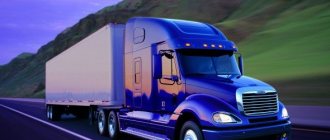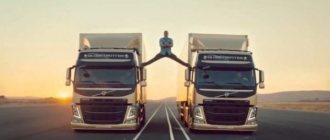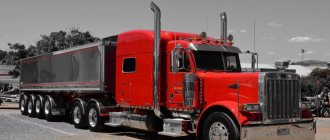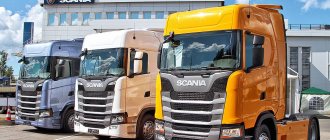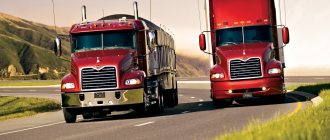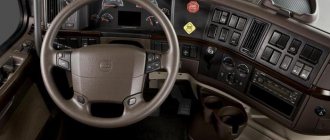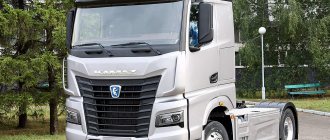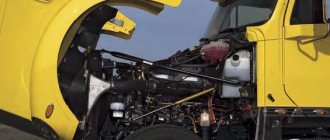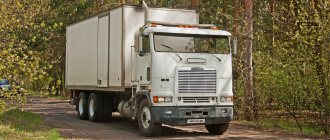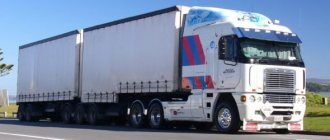Native "America"
Pavel Gamankov, photo by Maxim Shelepenkov
American hood tractors have become an integral part of our roads. On the federal highways “Moscow - St. Petersburg”, “Don” and some others, they make up almost a third of the traffic flow. At the same time, there is not a large variety of “State” monsters. Of the eight main truck manufacturers in the USA (Freightliner, Sterling, Western Star, Volvo, Mack, Peterbilt, Kenworth, International), only three are most widespread in Russia: International, Freightliner, Volvo. Tractor units of these exact brands were produced in 2002–2003. We decided to compare size group VIII (according to the classification accepted in the USA).
Why Yankees?
There are many reasons why American half-stellars quickly entered Russian reality. The first is the huge and stable demand for trucks. And any. It is quite obvious: Russia is ready to buy significantly more equipment than suppliers can offer. And they, in turn, cannot revise their shipping plans, because if you mobilize all your efforts to meet the needs of only Russia, you can lose customers in other markets within a few years. After all, there is also a fierce struggle for the consumer, and if you give away part of your pie now, getting it back later will be very problematic.
Russian businessmen also cannot saturate the market. Hence the acute shortage of cargo vehicles, especially in the heavy class. This applies not only to used cars, but also to completely new ones. Businesses often have to wait about a year for a custom car. And if there is demand, then there is supply. A logical confirmation of this was the appearance of products from Chinese automobile factories on the Russian market. They are always happy to sell anything if you are willing to buy. And an alternative to them was American used equipment.
But it would be wrong to motivate the popularity of overseas hoods only by the lack of cargo equipment. With the same success, used European cars could be supplied to us. The rates of customs duties for importing used equipment into Russia are the same for everyone. At the same time, “Europeans” often have an even smaller engine size. Of course, three- and four-year equipment from the Old World has not gained as much popularity in our country as the “Americans”. I wonder why?
Russia, like the United States, has vast territories without railway connections. Therefore, medium- and long-haul transportation accounts for the lion's share of the country's total freight turnover. And unlike the relatively small and densely packed Europe, where there is a branded car service at every turn, Russian and American spaces have virtually no infrastructure. Accordingly, for transportation in such countries, specific vehicles are needed - as reliable and passable as possible (hence the desire for a 6x4 wheel arrangement, and not 6x2, as in Europe). At the same time, they must be simple in design so that the driver can eliminate or at least determine the malfunction on his own. Engine power also plays an important role. This aspect receives a lot of attention in America, because cars often have to overcome mountainous sections with long climbs. The 6x4 wheel arrangement with inter-axle and inter-wheel locks is also not accidental. In the northern United States and Canada, snowy, icy roads are not uncommon, and high traction is essential in this case. All these problems are well known to our carriers, so the machines designed to solve transport problems, as they say, went off with a bang.
Not the least role in the choice of the “Americans” was played by the indestructible axles of the bonnets and the depreciation of the dollar, which, in comparison with the European currency, provides significant savings when purchasing both the cars themselves and components.
Owner reviews
Even those users who purchased a Volvo VNL 670 with a decent mileage (over 600 thousand kilometers) note excellent comfort and confident progress of the car both on flat areas and along mountain ranges. The modification, which underwent scheduled maintenance, behaved confidently and reliably for more than 50 thousand kilometers. After a series of minor repairs, the car confidently passed another 100 thousand.
Among the advantages are the owners who are distinguished by their reliability. The peculiarities of these power units include the complexity of the design; it is almost impossible to fix the breakdown on your own. In general, according to consumer feedback, the tractor is reliable, extremely comfortable, has good maneuverability and additional equipment.
Not just the hood
American trucks are created for a specific customer. Therefore, it is not easy to meet two identical “bonnets”. Our country mostly receives vehicles that transport companies ordered in large quantities, with a pre-agreed configuration, usually the simplest. For example, a characteristic feature of such cars is the absence of a rear drum cover. Brake pads are not protected from snow and dirt. Such is the saving. The cap is inexpensive, but, as they say, it comes with a price, and when ordering a large batch, a fleet company can save a lot of money. The situation is similar with mirrors, rims, and sleeping compartments. Sometimes there are even manual windows, like on the Freightliner Columbia we tested. The electric drive is only on the passenger door, so that the driver does not have to stretch. If you see a car with a “sleeper” separated from the cab with an external entrance door, rest assured: the car was in private hands and served as a home. Transport tickets are not exchanged.
Paradoxically, American trucks can be compared to Chinese ones. Both of them are a “hodgepodge” of components and assemblies from several manufacturers. The difference is that the Chinese install what they have on their cars, while the Americans install what the consumer orders. And if, for example, one Inter has a Cummins power unit, this does not mean that another cannot have a Detroit Diesel, Caterpillar or Volvo engine installed. Therefore, in our test we will compare not so much brands, but cars in a specific configuration. And the reason for comparison was the similar price and year of manufacture.
We tested a Volvo VNL64T670 with a Cummins ISX 450 engine, an International 9400 I with the same engine, and a Freightliner Columbia with a Detroit Diesel engine. The machines also differ in other components and assemblies, which we will talk about later. In the meantime, let's look at the external differences of the Yankees.
All of them have a typically American, but individual appearance. If we do not dwell on design solutions, then of the three tractors Volvo looks the freshest. If the “Fred” and “Inter” have a typical “USA” windshield made of two halves, then the “Volvo” has a huge solid monolith. And this is unlikely to please its owner in case of damage and replacement.
International and Freightliner are dotted with rivets traditional for “bonnet” models. This is not a tribute to tradition, but a feature of the manufacture of cabins and fastening of panels. At the same time, there are no rivets to be found on the Volvo - the cabin is made by welding. An original discovery by Volvo designers can be considered the holes in the sides of the hood for better cooling of the power unit. But the front bumpers on Volvo and Freightliner are three-section plastic, while on the International it is single, but metal. On the one hand, a composite bumper is cheaper to replace, but a metal one is much more difficult to damage.
The Volvo's hood opens from the cab, while the other two cars have traditional exterior latches. The tool boxes are also radically different. The Inter has a huge pass-through box, accessible from both sides of the car. The “Swede” of American origin (according to indirect evidence, there was a suspicion that it was aimed at the Mexican market) is also equipped with two drawers, but separate ones. But the covers are made so neatly that you may not even find them. But they saved money on Fred - only one tool box was installed.
All vehicles use two fuel tanks, the volume of which we have not yet determined. Typically tank capacities range from 100 to 300 gallons (approximately 400 to 1,150 liters). But on Volvo and International they are covered with plastic covers.
Peculiarities
It cannot be argued that the above-described characteristics of the Volvo VNL 670 and equipment are dogma. American manufacturers like to approach the process of creating cars creatively. Even modifications of the same batch differ from each other, although not significantly. For example, instead of one gearbox there may be another gearbox; engines of the same brand often differ in power and adjustments.
Consequently, one can talk about the standard configuration of the trucks in question or describe general parameters relatively, focusing on certain features of the structural units and their interaction. The first samples of VNL 67 appeared on the domestic market at the beginning of the 2000s of this century. Russian users highly appreciated the advantages of the hood configuration and the comfort of the workplace.
Apartments
The half-stellar cabins are located high above the road level, but getting there is quite easy - this is facilitated by wide steps and handrails. The driver's seats in cars are practically the same. They are equipped with air suspension, folding armrests and a large number of adjustments. And how long a particular seat is sat depends on who drove the car and how. It's no secret that there are plenty of fat people in the States. Passenger seats can be either sprung or rigidly installed.
International's interior is truly like something out of a good western. Western style instrument panel with wood grain finish. The instruments are not assembled in one block, as in the other two tractors, but are scattered like a garland throughout the instrument panel. The metal-spoke steering wheel looks more like a sports car than a truck. The interior looks cozy. But there are not enough drawers and boxes in the working part of the Inter cabin, only a few cup holders and a couple of niches above the side windows. By the way, Inter has the narrowest interior - only 175 cm; Volvo cabin internal width – 187 cm; Columbia - 192 cm. But Volvo and Fred have more than enough boxes. There are even trash bins provided. The console panel in these tractors is almost European, rounded towards the driver. The fuse box is hidden on the front panel, which the driver can reach without problems if necessary.
The combination of “Swede” and “Fred” instruments is made as a single unit. In Inter, instruments are scattered throughout the dashboard
The sleeping compartment, naturally, is of incredible size. It’s not for nothing that many drivers say that during long periods of parking they are ready to forgive the “Americans” literally everything - clumsiness, noise, and other shortcomings. We did not notice any particular differences in the sleeping compartments. Freightliner has the widest overhead bunk (90 cm, as in a compartment car), Volvo has the narrowest (76 cm), and International has the middle one (80 cm). The width of the lower ones in all cars is about a meter. But only in the Inter there are steps for access to the upper bunk (standard, like in a reserved seat carriage!).
The set of lockers is standard. You can mount everything here! And a small refrigerator, and a coffee maker, and a microwave. But, unfortunately, the cars arrive to us empty and the drivers are left to rejoice in the lockers for clothes, pull-out dining tables and a large chest under the bunk.
Performance tests
The tractor in question, regardless of the type of suspension (pneumatic or mechanical), all road irregularities pass smoothly, the impact from the chassis to the cabin is minimally transmitted. This design feature makes it possible to transport fragile cargo along “wonderful” Russian roads.
The truck has excellent steering feel, thanks to a powerful hydraulic booster with confident feedback. This is also facilitated by the propulsion mechanism, which practically does not transmit vibration moments to the steering wheel, making driving a pleasant and easy car. Given the significant length of the vehicle, maneuverability plays a significant role. Despite the fact that the road train fits a little worse than its European counterparts into tight spaces and turns, the ability to turn the front wheels by 50 degrees allows you to cope perfectly with parking, including in limited warehouse areas.
Dashing cowboys
In motion, each half-stellar has its own characteristic features. But what can be confidently said about all of them is that it is really difficult to maneuver in narrow passages. And if on the highway “Americans” are the kings of the roads, then in narrow warehouses they are elephants in a china shop. The long wheelbase makes itself felt, and it has to be taken into account. Freightliner is equipped with Meritor axles, the wheel steering angle reaches 50°. A decent result (most competitors have 45°), but even this does not save the bonnets from being sluggish. By the way, American tractors, depending on the customer’s wishes, can be equipped with Dana Spiser, International, and Eaton axles. But among Russian carriers, Meritor bridges and interlocks are especially valued, as they are supplied to equip US Army equipment. The layout with rear pneumatic and front mechanical suspension is considered traditional for American half-stellars. Although there are options with both full pneumatics and full mechanics. All tested cars are equipped with R22.5 wheels, although variations are possible here too.
The International, like the Volvo, is powered by a Cummins powertrain. The motors are completely identical in design and displacement. But thanks to the settings of the electronic fuel pump, Volvo designers squeezed out 450 hp. s., and the International engine produces only 400. But the International is equipped with an Eaton automatic transmission, which at first aroused some suspicions in me. In the sense that repairs due to the design feature can be quite expensive for the owner. But, as it turned out later, the Inter was equipped with a gearbox with the AutoShift system. That is, a conventional manual transmission with an automatic shift system. This is a completely different matter. It turns out that you get an order of magnitude more comfort, and in the event of a breakdown, repairs will not cost much more than conventional “mechanics”. But you need to get used to the joystick. To get moving, you need to move the lever forward and confirm your actions by pressing the button on the right side of the joystick. To engage neutral gear, just press the right button on the lever. Since the gearbox is essentially mechanical, there is no “Parking” position on the joystick, as on automatic transmissions.
Volvo and Freightliner have Eaton Fuller manual transmissions. Their design is slightly different, so there are some differences in handling the transmission. The Volvo uses a hydraulic clutch, while the Freightliner uses a conventional cable clutch. At the same time, not a single car is equipped with a pneumatic clutch booster. This makes the pedal very hard to press, especially on the Fred, so in a traffic jam you will have to fight a little with the clutch. One thing is reassuring: you only need to push it “to the floor” when starting from a standstill. Further shifts are made either with half-pressing the clutch, or without it, with a re-throttle. After some training, such tricks on bonnets can be accomplished without problems.
Volvo management is 100% European. The seating position, the familiar Swedish steering wheel with a comfortable grip, the ignition switch in the usual place on the right. Even the rounded hood is practically invisible. In principle, this is the “European” cabin, only with a huge “sleeper” and trim on the bow. International, on the contrary, is a purebred “American”: chrome-plated instruments, automatic transmission, straight hood. You feel absolutely confident, on the road you are a king and a god.
Freightliner Columbia falls somewhere in the middle. The hood is practically invisible, but the 430-horsepower engine is louder than its competitors. By the way, Fred has a mechanical fuel pump, so you always need to monitor the fuel level. If the engine gasps for air, it will be difficult to start. The clutch pedal is very tight.
But you can sit comfortably behind the wheel.
The steering column has a wide range of adjustments, all controls are at hand. Interestingly, the hazard warning lights turn on - just pull the right steering column switch towards you. Technical characteristics of tractors (according to manufacturers)
| Parameter | International 9400iSBA 230 | Volvo VNL64T 670 | Freightliner Columbia CL120 064S T |
| Wheel formula | 6x4 | 6x4 | 6x4 |
| Weight distribution along the axles of the tractor as part of a road train, kg | 5443/ 7711/ 7711 | 5670/ 9072/ 9072 | 5443/ 9072/ 9072 |
| Gross weight of the road train, kg | 40 800 | 40 824 | 40 000 |
| Curb weight of the tractor, kg | 6600 | 8480 | 7000 |
| Tires | 275/80R22.5G | 275/80R22.5G | 295/75R22.5G |
| Engine | |||
| Model | Cummins ISX 400, I-6 turbodiesel | Cummins ISX ST2 450, I-6 turbodiesel | Detroit Diesel 60, I-6 turbodiesel |
| Working volume, cm3 | 11 956 | 11 956 | 12 742 |
| Power, hp | 400 at 1600 min–1 | 450 at 1800 min–1 | 430 at 2100 min–1 |
| Maximum torque, N•m | 1966 at 1200 min–1 | 2102 at 1200 min–1 | 2046 at 1200 min–1 |
| Transmission | |||
| Transmission | Mechanical with Eaton Fuller FRP-15210 | Mechanical Eaton Fuller FRO-16210C | Mechanical Eaton Fuller FR-15210B |
| Number of gearbox stages | 10 | 10 | 10 |
| Chassis | |||
| Front suspension | Spring | Spring | Spring |
| Rear suspension | Pneumatic International Air Suspension | Pneumatic Volvo Air Suspension | Pneumatic |
| Front axle | Meritor FF-961 | Dana Spicer DST40 | Meritor FF-961 |
| Rear axle | Meritor | Meritor RT40 | Meritor RT40-145 R-SRS |
Tractor power indicators
Volvo's policy is that every model released is constantly improved. This trend extends to the tractor in question: high-tech Cummins developments are being introduced into the system of this machine. However, the basic technical characteristics of the Volvo VNL 670 are still competitive:
- torque (max) – 3150 Nm;
- average speed – 100 km/h;
- load max – 18 t;
- fuel consumption max – 40 l/100 km;
- Fuel tank volume – 16 l.
Volvo VNL 670 - rear view
Also, the Volvo VNL 670 has the following volumetric dimensions:
- total weight –7.1 t;
- cargo weight (max) – 30 t;
- road train weight – 40 tons;
- tractor length – 12.6 m;
- tractor width – 2.4 m;
- machine height – 2.6 m.
From the above indicators, you can see that the Volvo VNL 670 has powerful diesel performance and economical fuel consumption. Installing cruise control allows you to save up to 4% of fuel while driving. The permissible weight of transported cargo is proportional to the overall dimensions of the base vehicle and the complete road train.
Engine Cummins ISX15
The Cummins ISX15 engine installed on the model has performed well during numerous transportations. The power of this engine is 550 hp. With. The Volvo VNL 670 engine is equipped with additional protection and cooling systems. The exhaust gas recirculation system allows the engine to reduce overtime and save fuel. The presence of cleaning filters in the system also improves the functioning of the Volvo VNL 670 engine.
The basic equipment of the VNL includes a hydraulic power steering wheel, which makes driving more maneuverable and safe. The steering wheel is also protected by airbags that are deployed in the event of an accident.
conclusions
All things being equal, the International 9400i costs slightly less than the Volvo VNL64T670 and Freightliner Columbia. This is partly explained by the fact that in America they are positioned as budget tractors, and accordingly they are cheaper than their competitors. If you are interested in a real American tractor, you won't find a better International. As a bonus - a gearbox with AutoShift system. If you prefer the European type of trucks, but due to the design features of the 6x4 drive, frequent overnight stays, etc., you need a hood, your choice is Volvo. Freightliner Columbia traditionally sits somewhere in the middle. Just a good, reliable car, capable of providing decent comfort on the road, but not brimming with bells and whistles.
Volvo car design
Volvo VNL 670
A serious difference between the Volvo VNL 670 truck tractor and other similar machines is its design, which combines the experience of American and European practice. American cars stand out because they are designed with driver comfort and cargo safety in mind. Layout options for foreign models imply the presence of large living compartments and biaxial wheel landing.
European-made tractors are distinguished by easier assembly, including single-axle design. Thanks to a unique selection of components, the Volvo VNL 670 tractor harmoniously combines reliability and convenience. This model is a union of American and European automotive products: the supporting base and driver's cabin are made by Volvo, and the remaining parts are purchased from American suppliers.
In 1997, a test model of this tractor was released; since then, the VNL vehicle has repeatedly demonstrated its power qualities at its best. The automobile experiment from the developers of the Volvo VNL 670 turned out to be very successful and established itself as a powerful power tractor.
